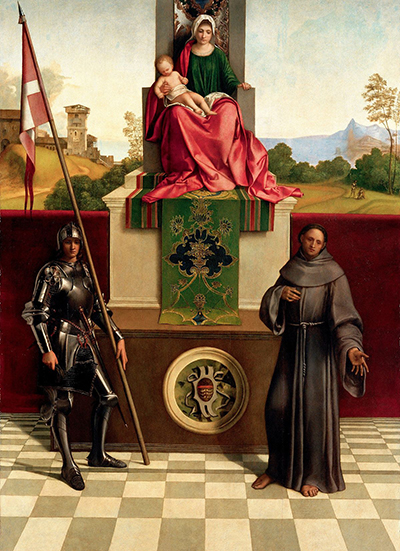The Castelfranco Madonna is one of the few works that can unequivocally be attributed to Giorgione. Named the Castelfranco Madonna as it is housed in the town's cathedral, it is alsoknown, perhaps more accurately, as the Madonna and Child Between St. Francis and St. Nicasius.
It was commissioned by Italian Soldier Tuzio Costanzo after the untimely death of his son, Matteo. Today it adorns both Matteo and Tuzio’s tombs, as the father was later interred with his son. The Castelfranco Madonna can be dated from 1508-1509. It is one of Gorgione's earliest works and believed to be his only known altarpiece. The work is composed of four figures; the Virgin sits on a high throne, cradling the Christ child, and on the lower ground, she is flanked by a warrior dressed in armour to the left of the painting, and a saintly figure dressed as a monk to the right.
The warrior figure was originally considered to depict Saint George due to his battle dress, and later perhaps Saint Liberalis as he is the patron saint of Castelfranco. However, modern scholars believe that it is another saint entirely. Matteo, whose tomb the altarpiece watches over, was a member of the Knights of Rhodes, and the figure carries the flag of the order. It is therefore widely accepted that the figure is, in fact, Saint Nicasius, the patron of the brotherhood. The other figure is of course, Saint Francis, the patron saint of Italy.
The background of the painting is, typical to Giorgione's style, a beautiful description of an Italian landscape. Even in his earliest works it is clear how important nature is to Giorgione, more important than any religious reference, which is conspicuous by its absence. The elements of the Castelfranco Madonna are a fairly traditional "sacra conversazione" or holy conversation where the Virgin and Child and surrounded by saints. However, Giorgione has taken these simple symbols and elevated them through the use of colour and composition into something truly moving and celestial.
While it was quite common to depict the Virgin sitting on a throne in altarpiece work, it was very unusual to raise the figure quite so high above the others. In doing this, Giorgione has insisted that the viewer notices the sorrow in the faces of the Christ child and the Madonna as we follow their gazes to the tomb over which they sit. We can feel the grief of loss from both Jesus and Mary. The clever use of the green cloth brings us to the saints below, connecting the sorrow, as above so below.
It is then that we are made aware that all the figures are gazing at the tomb of Costanzo’s lost son. Through Giorgione's skilful use of colour, light and composition, he has again created a moving and evocative masterpiece which not only conveys the mourning of a father for his son, but also the sadness of a life ended too soon. A poignant thought as Giorgione himself died at only 33 years of age.
Giorgione's Castelfranco Madonna is one of the earliest examples of what art historian, Giorgio Vasari, called "pittura sanza disegno" or painting without drawing. The idea of painting colours and movement as you perceive them may sound fairly obvious to modern artists, but in Renaissance Europe, it was ground breaking. The technique was pioneered by Giorgione in this altarpiece bringing emotion and depth as never before seen, but it was mastered in his later work, The Tempest. Titian, Giorgione's student and friend later expanded and perfected this style and it became the “signature” of the Venetian school.




